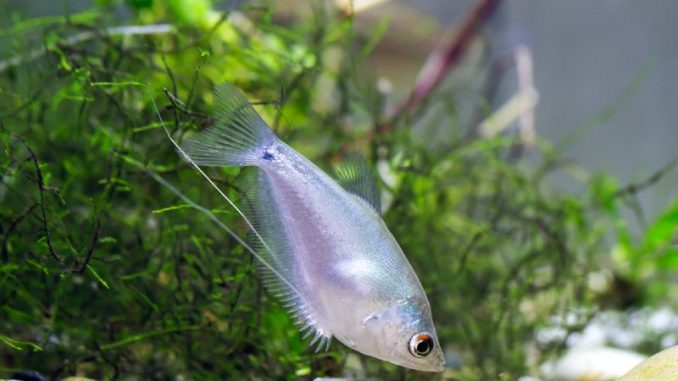
The moonlight gourami (Trichopodus microlepis), also known as the moonbeam gourami, is a medium-size freshwater labyrinth fish originating from South-East Asia.
This fish is native to the slow-running rivers of the tropical regions of Cambodia, Vietnam, and Thailand. It comes from the broader family of gouramis, or Osphronemidae.
The moonlight gourami is a popular choice for both experienced and novice aquarists due to its peaceful nature and unique silver coloring which makes it stand out from the crowd in any fish tank.
This fish is relatively easy to care for due to its adaptability, and it brings sparkle and color to any aquarium. However, you should be careful to provide moonlight gouramis with acceptable tank conditions and ensure these fish can enjoy enough space and familiar tropical water temperatures.
TABLE OF CONTENTS
Moonlight Gourami Facts & Overview
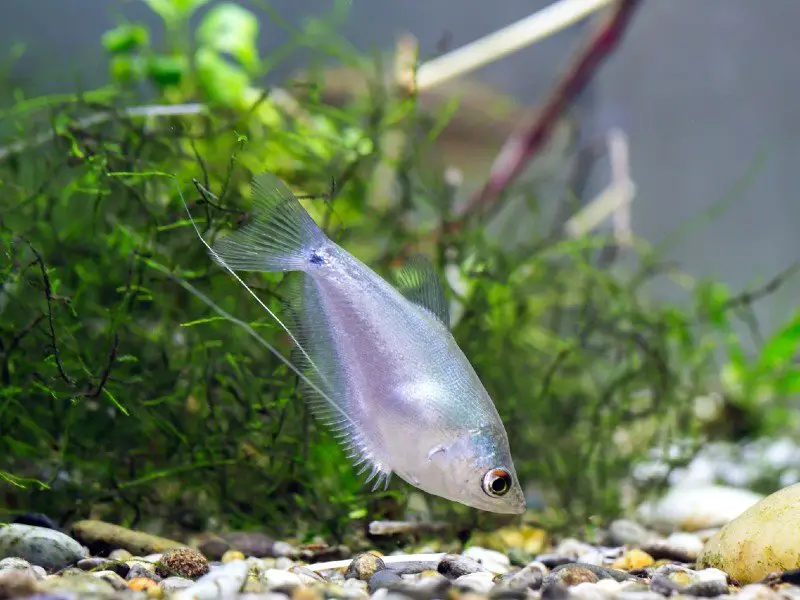
| Category | Rating |
| Care Level: | Moderate |
| Temperament: | Peaceful |
| Color: | Silver with green iridescence |
| Lifespan: | ~4 years |
| Size: | ~5.1 inches |
| Diet: | Omnivore |
| Family: | Osphronemidae |
| Minimum Tank Size: | 20 gallons |
| Tank Set-Up: | Freshwater, plants, floating plants |
| Compatibility: | Peaceful, medium-size species |
The moonlight gourami is a freshwater labyrinth fish, which is a type of tropical fish, comes from the family scientifically known as Osphronemidae composed of other gourami species. In general, gouramis are native to South and South-East Asia, originating in countries from Pakistan to South Korea.
The name “gourami” comes from the Indonesian language. The moonlight gourami got its name from its unique silver color with greenish sparkle, reminiscent of the light of the moon.
Moonlight gouramis typically live in slow-water rivers and shallow ponds with rich tropical vegetation, enjoying the shade from the plants, mild streams of water, and relatively high water temperatures. The tank moonlight gouramis live in should not have a strong stream pump.
These fish also require a lot of vegetation in the tank and are happy with some plants floating at the top of the tank, protecting them from bright electric lights. The ideal water temperature for moonlight gouramis is between 77°F and 86°F.
In the wild, moonlight gouramis are common, as they occupy a broad range of habitats across their region of origin. However, moonlight gouramis can sometimes be overlooked by aquarists, which is why one might not find this fish in a shop immediately. In the US, you can usually purchase this fish for around $10 USD.
Appearance & Behavior
The moonlight gourami is a beautiful fish known for its distinct silver coloring with the potential of developing a more complex green, iridescent shade as the fish matures. This fish usually has a prolonged and flat body, with a distinct head that has a slight concave curve at the top.
Moonlight gouramis have fragile, almost transparent fins that also show some iridescence consistent with the overall color of the fish. As moonlight gouramis grow up, males tend to develop bright red or orange coloring on their elongated pelvic fins, while the same fins stay colorless or yellowish in female fish. A male’s dorsal fins would also be longer compared to a female.
Moonlight gouramis usually reach a size of 5-6 inches (12-15 cm). Males can sometimes be smaller than females.
Typical Behavior
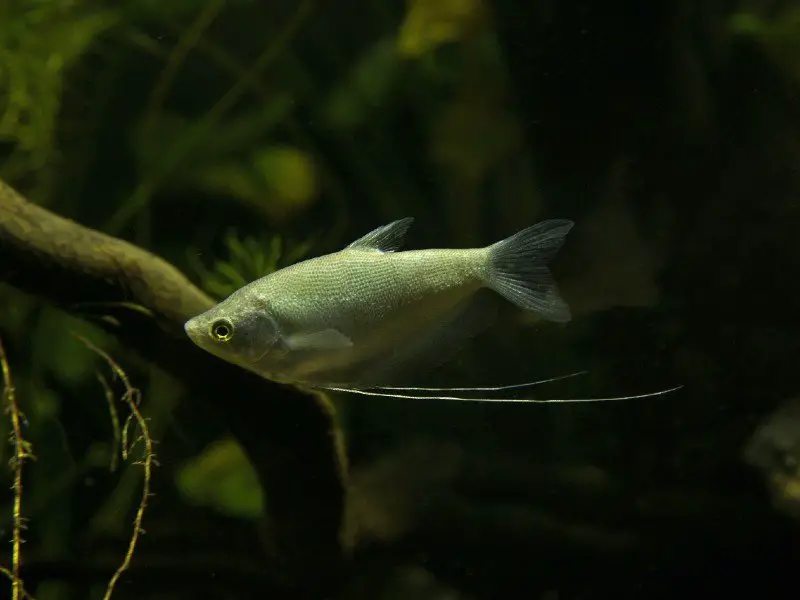
The moonlight gourami is a peaceful fish, suitable for a diverse tank community. This fish is normally passive, as well as slow and gracious in its movement around the aquarium. The moonlight gourami swims in the middle and top parts of the tank.
This fish is usually most active during the daytime, which gives its owner a chance to capture its beauty in the natural light of day. Nevertheless, due to its origin in the vegetation of tropical rivers, it also requires hiding spots.
The moonlight gourami sometimes swims to the top of the tank to breathe in the oxygen above the water, due to its special lung-like organ called a labyrinth organ. The fish developed this organ living in swamps and ponds with low oxygen levels in the waters.
Moonlight gouramis also get along with most other species who display similar behaviors. They are peaceful fish that can be affected by the aggressive behaviors of other more territorial species. However, with age, male moonlight gouramis may also display signs of territorial behaviors. They can also develop territorial traits after breeding.
Moonlight Gourami Care
The moonlight gourami is a relatively easy fish to care for and suits even inexperienced aquarists. Moonlight gouramis are not particularly demanding of the pH and acidity levels in the water. However, they require the water to be changed regularly to ensure they stay healthy.
Key tank requirements for moonlight gouramis are elaborate vegetation and specific water plants, enough space in the aquarium, and appropriate water temperatures since these fish are used to tropical habitats.
Moonlight gouramis are also quite easy to feed, as they can adjust to a diverse diet consisting of live and dried foods. They also have a naturally high level of health and are not prone to any specific dangerous fish diseases except for some rather common ones that are relatively easy to prevent and treat.
Disease
The moonlight gourami is a generally healthy fish if it is provided with the appropriate tank conditions, regular cleaning, and a balanced diet. However, sometimes moonlight gouramis can develop bacterial infections if the water conditions are not good enough.
In addition, any new fish in the tank can be a threat to the health of the inhabitants and introduce disease. You should make sure that every new fish you plan on introducing into the aquarium undergoes quarantine.
If your moonlight gourami catches an infection, the best way to prevent further spread is to treat it early and quickly isolate the fish from the aquarium.
Habitat and Tank Requirements
Moonlight gouramis are used to slow-running freshwater rivers, ponds, or swamps. Therefore, they are used to murky waters with a lot of rich tropical vegetation and floating plants on the surface.
These fish also require plenty of space to feel safe in the tank, which means you should consider a bigger tank if you want to introduce moonlight gouramis to your fish family.
Tank Conditions
Moonlight gouramis always require fresh water in the aquarium that matches the familiar temperatures of their native rivers in South-East Asia. Therefore, the temperatures in the tank should range between 77°F and 86°F. These fish do not require any specific substrate and can get accustomed to any.
Given their size in adulthood of up to 6 inches, moonlight gouramis require a lot of space to swim around the aquarium. When considering a tank for moonlight gouramis, make sure you choose one that is no smaller than 20-25 gallons. However, ideally, a tank should be between 30 and 40 gallons for these fish to feel safe and comfortable.
In a smaller tank, they will feel stressed and have fewer spaces to hide, which can have a negative impact on their overall health.
The moonlight gourami also needs a variety of tropical plants in the aquarium, including some floating plants. However, keep in mind that this fish is known for biting on plants, which means that delicate plants with thin leaves will be quickly destroyed. However, planting some thick-leaved plants, like Java fern, would be a great alternative for moonlight gouramis, also serving as good hiding spaces for this species.
These fish also enjoy a gentle filtration system installed in the tank, but will struggle with a strong water pump creating an active current that would only push them around the tank and exhaust the fish.
Tank Mates
Moonlight gouramis feel most comfortable in a tank when kept in pairs or groups. The moonlight gourami is a peaceful and adaptable fish that can be a great addition to a friendly tank community. Some of the best tank mates for the moonlight gourami would be other types of calm tropical fish.
Moonlight gouramis get along well with medium-size non-aggressive fish, like freshwater angelfish, corydoras, or even shrimp, like the amano shrimp.
However, make sure that you do not place moonlight gouramis in the same tank with fin-nipper fish that might attack moonlight gouramis and destroy their fine transparent fins. Some of the fish that would not be good tank mates for moonlight gouramis are the tiger barb or the Siamese fighting fish, also known as betta fish.
In addition, when selecting tank mates for the moonlight gourami, make sure you do not introduce very small fish into the aquarium, as they can be targeted by this species, especially at a young age.
Diet and Feeding
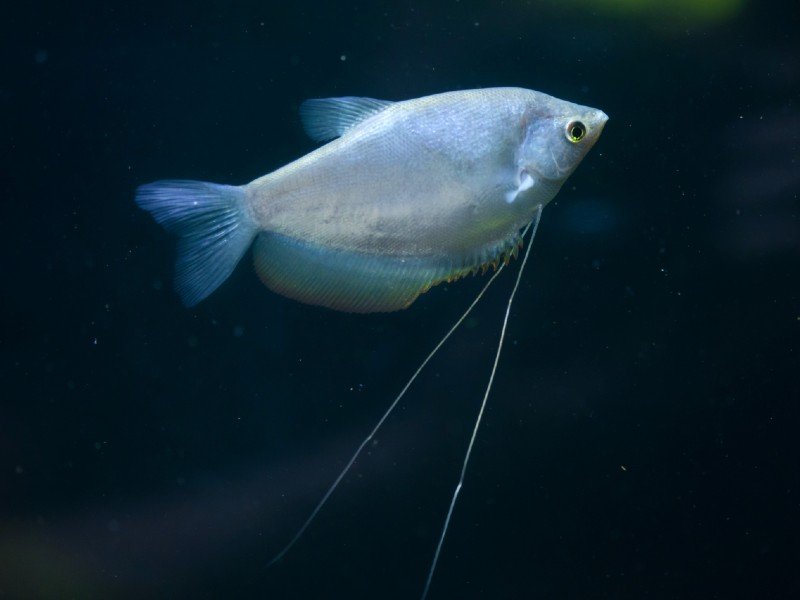
Moonlight gouramis are omnivores and easily adapt to a variety of diets and foods you select for them. They happily accept dried, frozen, or live foods. However, if you want your fish to be healthier and live longer, the best approach to their diet is to incorporate a variety of different foods.
This species prefers blood worms, general fish flakes, small insects, and plant matter. You should feed your moonlight gouramis once or twice a day. An optimal amount of food for them would be what they can eat in two minutes.
Keep in mind that moonlight gouramis are peaceful and non-aggressive fish, which means they will not pick a fight over food. Larger and more aggressive species can take food away from timid moonlight gouramis, so you should make sure this fish gets enough food if it shares a tank with more aggressive fish.
Breeding
To breed moonlight gouramis at home, there are some steps to follow. First of all, it is important to note that this species, like most gouramis, is known for building so-called bubble nests for breeding — a floating nest at the top of the tank attached to a high-rise plant. To make a nest, moonlight gouramis blow small bubbles of air that gather on the surface of the tank, to which they can then attach their eggs.
When you breed moonlight gouramis, make sure to have a separate breeding tank, as other fish in the aquarium can consider their bubble nests as food and eat the eggs.
Separate males and females in different tanks for two weeks to prepare them for breeding. Provide these fish with a rich and healthy diet, including more live foods, as well as peaceful tank conditions to reduce stress.
Once the fish are ready, place the male and female into the breeding tank with a slightly warmer water temperature of at least 80°F and some floating plants for the fish to attach the bubble nest to. The spawning process should begin within a few days.
The male will start to carefully prepare the bubble nest, after which it will court the female with a fascinating courtship dance. After the dance, the female is ready to release her eggs, which will then be fertilized by the male.
The female might release up to 2,000 eggs at once, which will remain attached to the bubble nest for several days before hatching. To make sure the hatchlings survive, make sure the water is kept above 80°F. Over the first few days after hatching, release small foods into the tank, like baby brine shrimp, as well as infusoria and liquid fry.
In addition, remove the parents from the breeding tank to stop them from eating the hatchlings.
Should You Get a Moonlight Gourami for Your Aquarium?
Moonlight gouramis are a fantastic addition to almost any tank. This is a beautiful tropical fish that is highly adaptable, easy to care for, and mesmerizing to watch in an aquarium.
Before buying moonlight gourami, make sure you have enough space for a larger tank, which you will require as your fish grows to its adult size. You should also be prepared to pay attention to your fish and maintain healthy water conditions for your moonlight gouramis to thrive.
Despite being a relatively easy fish to take care of, the moonlight gourami might not be the best choice if you already have some aggressive and territorial fish in your tank.
Nevertheless, the moonlight gourami is a great fish that will bring color and grace to your aquarium, and become a beautiful addition to a friendly tropical fish family.

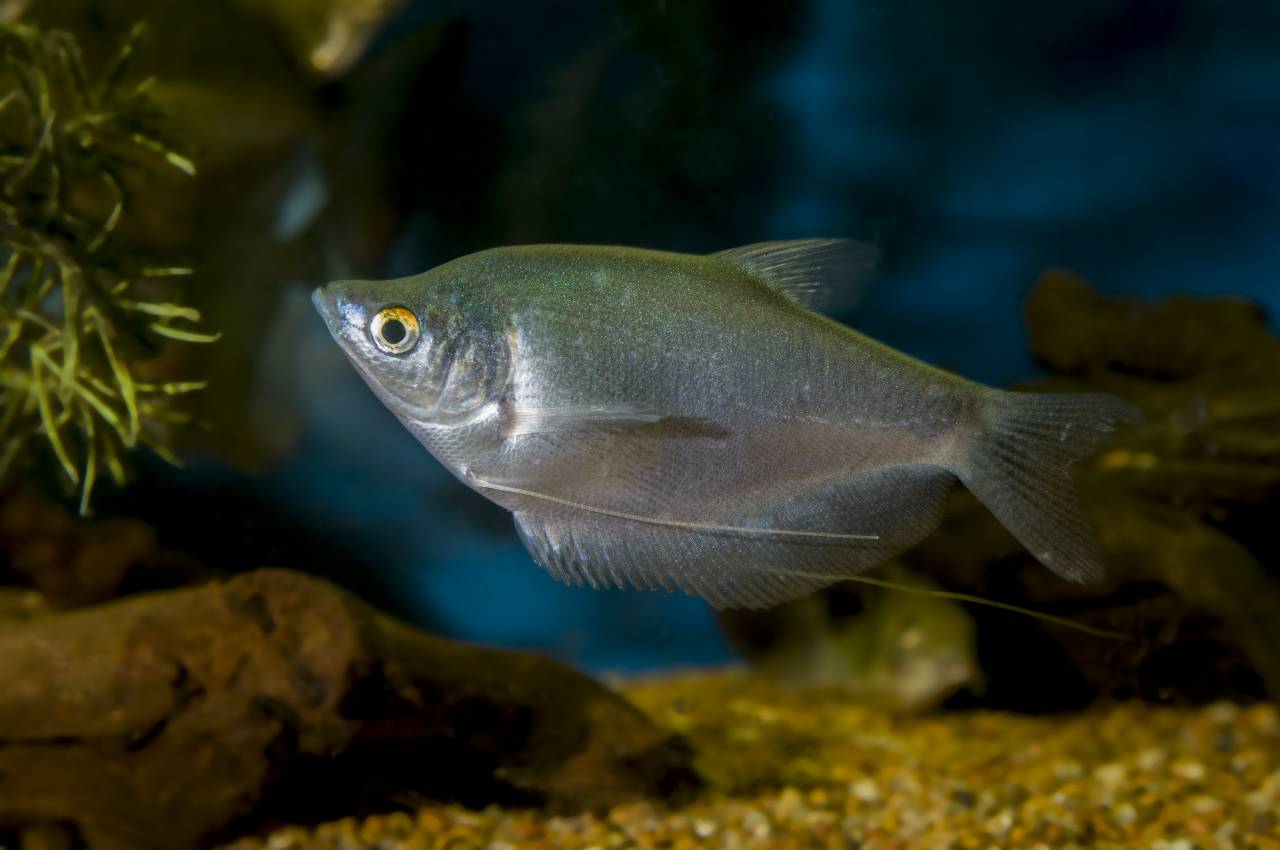
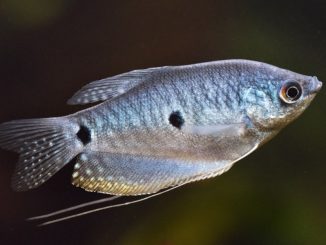
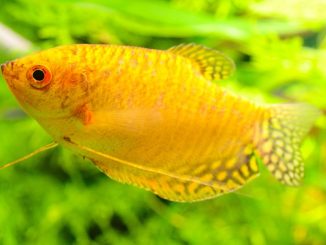
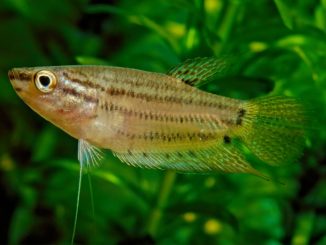

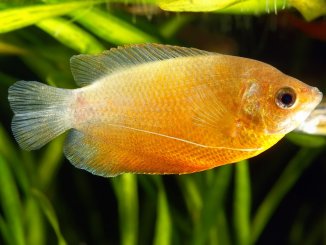
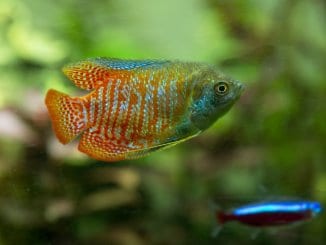
Be the first to comment